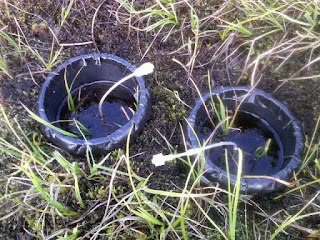Because not all our packages had arrived in Barrow due to
fog, I took the opportunity to visit with the one set of scientists working in
the nearby thaw lake basin. It was a short walk and, within 15 minutes, we were
talking about greenhouse gas emissions and the geochemical and microbial
mechanisms responsible for CO2 and CH4 emissions from the tundra.
I learned that this group of investigators (Kim, Elliot,
and Cristina) were all working with project PI David Lipson from San Diego
State University. David has worked in Barrow for several years now. Kim and
Elliot are PhD students at SDSU and Cornell University, respectively. Both are
apparently close to completing their dissertation research. Neither of these
two had a problem with walking 2 km to their "office on the tundra"
every day and both were really excited to talk about their research. It was
nice to see that level of enthusiasm in young scientists.
In talking with the two students, I came to understand
that Kim is conducting small manipulative experiments where she adds humics or
iron to small "micro" plots defined by PVC collars. She then measures
gas exchange from these treatments, comparing flux rates to those of the
controls. Kim is interested in learning more about how electron
donors/acceptors affect microbial processes and the cascade of consequences
that ultimately lead to greenhouse gas emissions. Small samplers inserted into
the soil allow Kim to withdraw a sample of pore water for later geochemical
analysis.
Elliot is doing something similar to that of Kim, but
rather than add different compounds to soils, he is using electrodes to create
a variable electron environment for microbes and then measuring impacts on CO2
and CH4 fluxes. The instruments that he was using were fairly sophisticated and
I could only imagine the challenges he faces in keeping everything running.
Today, Kim and Elliot were assisted by Christina. Christina is
a PolarTREC teacher from Los Angeles, having been selected to participate in a
science project for the summer in hopes that she will take some of that
experience back to her class of 8th grade students. TREC stands for
'Teachers and Researchers Exploring and Collaborating'. The PolarTREC program requires that the
teacher develop a direct connection with a particular faculty member and write
a proposal outlining how knowledge gained will be transferred back to students
in the classroom. I am sure that Christina's students will enjoy hearing
stories about her Arctic experiences.
Thirty minutes later, I found myself walking back to our
NGEE Arctic field site having introduced myself to three interesting people.
The informal setting of the tundra made it possible to meet others working in
the area. It reminds me that various groups share the BEO and there are
definite benefits to be gained by asking others about their research. Now if
only those two students from Craig Tweedie's laboratory (at the University of
Texas, El Paso) would just fly their kite...now that would be cool.




